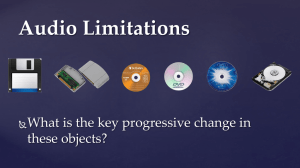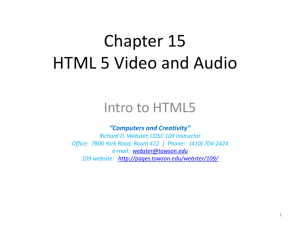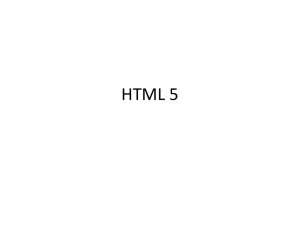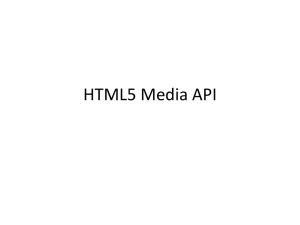Basics of Web Design: Chapter 10
advertisement
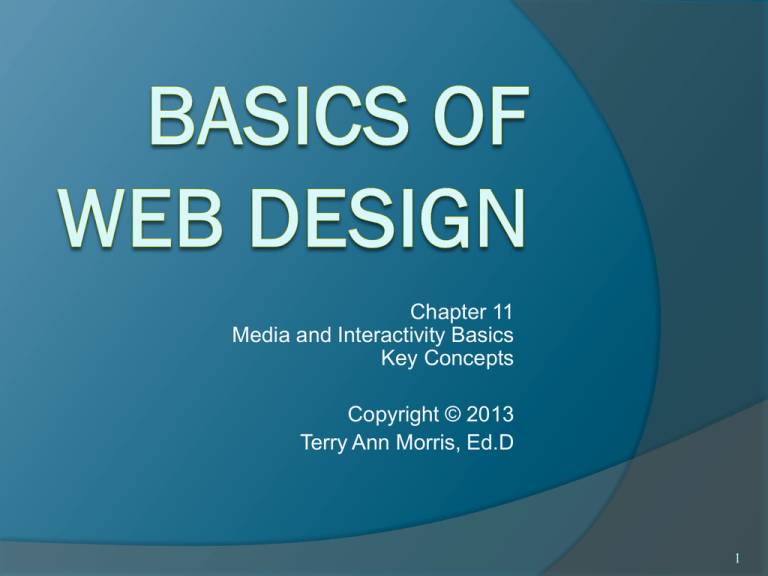
Chapter 11
Media and Interactivity Basics
Key Concepts
Copyright © 2013
Terry Ann Morris, Ed.D
1
Learning Outcomes
Describe types of multimedia files used on the Web
Configure hyperlinks to multimedia files
Configure audio and video on a web page with HTML5 elements
Configure a Flash animation on a web page
Use the CSS3 transform and transition properties
Describe the purpose of the HTML5 canvas element
2
Helper Applications & Plug-ins
Helper Application
A program that can be designated to handle a particular
file type (such as .wav or.mpg) to allow the user to view
or otherwise utilize the special file.
The helper application runs in a separate window from
the browser.
Plug-In
A newer and more common method
Plug-ins run right in the browser window so that media
objects can be integrated directly into the web page.
3
Containers & Codecs
Container
Designated by the file extension – contains the
media and metadata
Codec
The algorithm used to compress the media
HTML5 audio & video
Native to the browser
Browsers do not support the same codecs
4
Commonly Used Plug-ins
Adobe Flash Player
Adobe Reader
Windows Media Player
Apple Quicktime
5
Common Audio File Types
.wav
.aiff
.mid
.au
.mp3
.ogg
. m4a
Wave File
Audio Interchange File Format
Musical Instrument Digital Interface (MIDI)
Sun UNIX sound file
MPEG-1 Audio Layer-3
Ogg Vorbis (open-source)
MPEG 4 Audio.
This audio-only MPEG-4 format is
supported by Quicktime, iTunes, and iPods.
6
Common Video File Types
.mov
Quicktime
.avi
Microsoft Audio Video Interleaved
.wmv
Windows Media File
.flv
Flash Video File
.mpg
MPEG (Motion Picture Experts Group)
.m4v .mp4 (MPEG-4)
.ogv
Ogg Theora (open-source)
.webm VP8 codec (open video format, free)
7
Copyright Issues
Only publish web pages, images, and other media that
you have personally created or have obtained the
rights or license to use.
Ask permission to use media created by another
person instead of simply “grabbing” it.
All work (including web pages) are automatically
copyrighted even if there is not copyright mark or date.
Fair Use Clause of the Copyright Act
Creative Commons – A new approach to copyright
8
Configure Audio & Video
Most basic method to provide audio or
video files:
Hyperlink
<a href=“wdfpodcast.mp3" title=“Web Design
Podcast”>Web Design Podcast</a>
9
Multimedia & Accessibility
Provide alternate content
Transcript (for audio)
Captions (for video)
Text format
10
What is Adobe Flash?
A popular multimedia application
Create multimedia which adds visual interest and
interactivity to web pages
Flash movies are saved in “.swf” files
Perception of speedy display
.swf files play as they download
Flash Player
Free browser plug-in
Widely installed on browsers
11
HTML5 Embed Element
<embed type="application/x-shockwave-flash"
src="fall5.swf"
width="640"
height="100"
quality="high”
title="Fall Nature Hikes">
12
HTML5 Audio & Source Elements
<audio controls="controls">
<source src="soundloop.mp3" type="audio/mpeg">
<source src="soundloop.ogg" type="audio/ogg">
<a href="soundloop.mp3">Download the Audio File</a>
(MP3)
</audio>
13
HTML5 Video & Source Elements
<video controls="controls" poster="sparky.jpg"
width="160" height="150">
<source src="sparky.m4v" type="video/mp4">
<source src="sparky.ogv" type="video/ogg">
<a href="sparky.mov">Sparky the Dog</a> (.mov)
</video>
14
Use the iframe
element
to embed
YouTube Video
<iframe src="http://www.youtube.com/embed/VIDEO_ID"
width="640" height="385">
View the
<a href="http://www.youtube.com/watch?v=VIDEO_ID">YouTube
Video</a>
</iframe>
15
CSS3 Transform Property
Allows you to rotate, scale, skew, or move an
element
Example:
-webkit-transform: rotate(3deg);
-moz-transform: rotate(3deg);
-o-transform: rotate(3deg);
-ms-transform: rotate(3deg);
transform: rotate(3deg);
16
CSS3 Transition Property
Provides for changes in property values to
display in a smoother manner over a
specified time.
Example:
nav a:hover { color: #869dc7; background-color: #eaeaea;
-webkit-transition: background-color 2s linear;
-moz-transition: background-color 2s linear;
-o-transition: background-color 2s linear;
transition: background-color 2s linear; }
17
HTML5 Canvas Element
Configures dynamic graphics
Draw lines, shapes, text, image
Interact with actions taken by the user
Canvas API (application programming interface)
JavaScript – client-side scripting language
<script>
function drawMe() {
var canvas = document.getElementById("myCanvas");
if (canvas.getContext) {
var ctx = canvas.getContext("2d");
ctx.fillStyle = "rgb(255, 0, 0)";
ctx.font = "bold 3em Georgia";
ctx.fillText("My Canvas", 70, 100);
ctx.fillStyle = "rgba(0, 0, 200, 0.50)";
ctx.fillRect (57, 54, 100, 65);
}
}
</script>
18
Summary
This chapter introduced the HTML techniques and
technologies used to configure sound, video, and
interactivity on web pages.
Issues related to accessibility and copyright were also
discussed.
The number one reason for visitors to leave web
pages is too long of a download time. When using
multimedia, be careful to minimize this issue.
19








